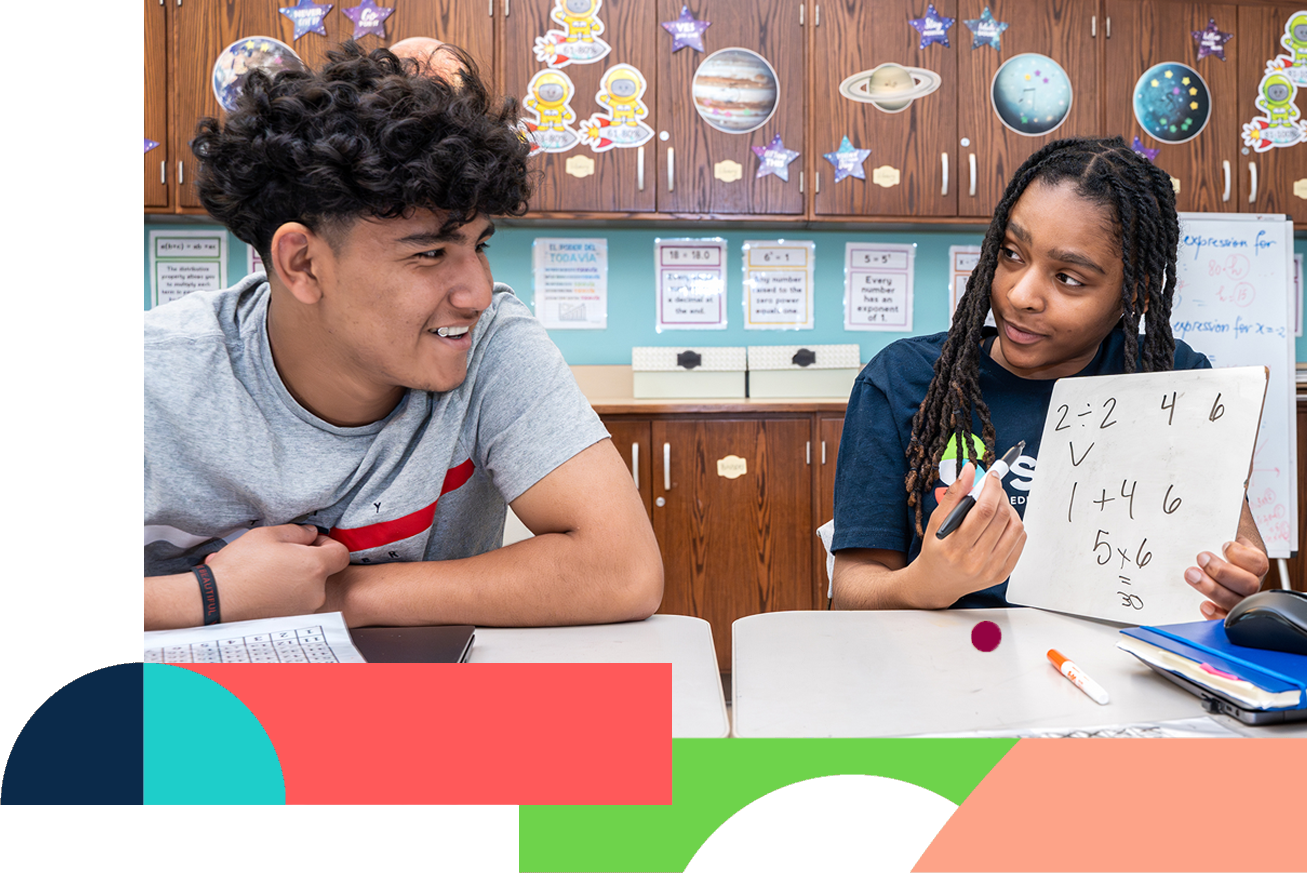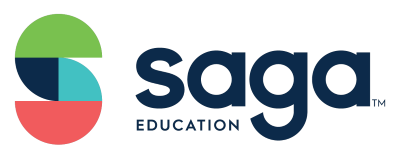by Robert Runcie, CEO of Chiefs for Change and former Superintendent, Broward Country Public Schools; and Alan Safran, CEO of Saga Education
This perspective will feel to some educators and families like it is ahead of its time–because parents, teachers, and most students disliked remote classroom teaching during the early stages of the COVID-19 pandemic and hardly
want to think about it now. And yet, we are urging a new and crucial look at how live-online tutoring can and does provide high-quality instructional support for our students and is crucial to accelerating learning and recovery.
We need look no further than recent news reports to see the devastating results of the nation’s forced experiment on remote teaching: “Two Decades of Growth Wiped Out by Two Years of Pandemic,” The 74 declared.
Given all that, it would be easy for K–12 districts to insist on providing only in-person learning experiences for students. That would be a huge mistake for the students we serve.
Tutoring remotely—as part of the regular school day—may be the best pathway for districts to accelerate learning and recovery.
Despite the many challenges of teaching students in remote, online classrooms, it turns out that tutoring them remotely—as part of the regular school day—may be the best pathway for districts to boost academic achievement and for scaling tutoring to reach some of the most underserved students in our country. Two recent studies of live-online tutoring programs in Italy and Spain, for example, showed encouraging signs that tutoring remotely can help children succeed. Note that we are distinguishing remote tutoring, which is online with a live tutor, versus online instruction, which often means a student sitting in front of a computer-based practice platform without another human.

In the U.S., The New York Times recently called for more research into the effectiveness of live-online tutoring, calling it “potentially transformative” because it “could greatly expand the pool of trained tutors available to schools.” It also could become a more cost-effective solution for districts where the cost of making in-person high-impact tutoring widely available would be too great. Trish Cook, a teacher at Uplift Gradus Preparatory, a charter public school in DeSoto, Texas, recounted her fourth-graders’ experiences with a fully remote math tutoring service: “These were trained tutors—it was clear they had some educational and leadership background, and morale went up.”
Here are three reasons district leaders should consider scalable, in-school-day live-online tutoring programs now and for the long term:
Live-online tutoring is the only equitable solution.
 All students can benefit from working with a tutor throughout their K–12 careers–especially at the critical leverage points of grade 3 literacy and grade 9 math (students who are proficient in reading by grade 3, like students who pass algebra 1 by grade 9, have a four times greater graduation rate than students who do not reach these milestones). Finding in-person tutors (let alone in-person teachers) is a serious challenge for many urban and rural districts. But open up a national pool of remote tutors, and the labor shortage is resolved. Districts then can be very selective about which tutors they want–even adding tutors who speak the languages of their students when they can’t secure local tutors with this skill.
All students can benefit from working with a tutor throughout their K–12 careers–especially at the critical leverage points of grade 3 literacy and grade 9 math (students who are proficient in reading by grade 3, like students who pass algebra 1 by grade 9, have a four times greater graduation rate than students who do not reach these milestones). Finding in-person tutors (let alone in-person teachers) is a serious challenge for many urban and rural districts. But open up a national pool of remote tutors, and the labor shortage is resolved. Districts then can be very selective about which tutors they want–even adding tutors who speak the languages of their students when they can’t secure local tutors with this skill.
Students really can form relationships with their tutor.
During the first year of COVID-19, teachers struggled to build personal connections with students because they were delivering remote lessons to virtual classrooms of 25 or more. Saga sites around the US have shown that students can and will form strong relationships with their remote tutors. The key is that the platform for remote tutoring must recreate in the vertical world of the computer screen what was created in the traditional horizontal world of in-person tutoring across a table. Cameras, audio, and chat need to be on, and the students in the room at school need to be supervised by an onsite adult to ensure this. And importantly, tutors can work remotely with two to four students at a time and continue working with the same students each day, which allows individualized instruction and peer-to-peer interactions.
Live-online tutoring offers instructional advantages over in-person tutoring.
Some of this revolves around the confidentiality uniquely provided by live-online tutoring. Students tutored in person are often embarrassed to truthfully tell their tutor if they’re ready to move on from a lesson, but in the remote environment, the tutor asks the students privately to  chat a number on a 1-10 scale, and the tutor can then adapt their next lesson to accommodate the student who was too shy to admit they didn’t feel ready to proceed. Likewise, it is crucial for tutors to be observed and given on-the-job coaching; but if an observer sits at an in-person tutorial table, the dynamics will change. Remote observations, done surreptitiously and frequently by the supervisor on the tutoring platform, can provide reality for the observer and actionable feedback for the tutor to improve (not to mention a quality audio/visual recording to roll for the tutor, like a coach would do to improve an athlete’s techniques).
chat a number on a 1-10 scale, and the tutor can then adapt their next lesson to accommodate the student who was too shy to admit they didn’t feel ready to proceed. Likewise, it is crucial for tutors to be observed and given on-the-job coaching; but if an observer sits at an in-person tutorial table, the dynamics will change. Remote observations, done surreptitiously and frequently by the supervisor on the tutoring platform, can provide reality for the observer and actionable feedback for the tutor to improve (not to mention a quality audio/visual recording to roll for the tutor, like a coach would do to improve an athlete’s techniques).
Consistently high-quality live-online tutoring can be delivered at scale, by districts, to the students who need it most. It offers an immediate pathway to accelerate learning and recovery and the possibility of a long-term solution to redesign schools and close persistent and unacceptable opportunity gaps. We now have the means to do so. Do we have the will?
Learn more about how high-impact tutoring is helping with learning recovery.



 All students can benefit from working with a tutor throughout their K–12 careers–especially at the critical leverage points of grade 3 literacy and grade 9 math (students who are proficient in reading by grade 3, like students who pass algebra 1 by grade 9, have a four times greater graduation rate than students who do not reach these milestones). Finding in-person tutors (let alone in-person teachers) is a serious challenge for many urban and rural districts. But open up a national pool of remote tutors, and the labor shortage is resolved. Districts then can be very selective about which tutors they want–even adding tutors who speak the languages of their students when they can’t secure local tutors with this skill.
All students can benefit from working with a tutor throughout their K–12 careers–especially at the critical leverage points of grade 3 literacy and grade 9 math (students who are proficient in reading by grade 3, like students who pass algebra 1 by grade 9, have a four times greater graduation rate than students who do not reach these milestones). Finding in-person tutors (let alone in-person teachers) is a serious challenge for many urban and rural districts. But open up a national pool of remote tutors, and the labor shortage is resolved. Districts then can be very selective about which tutors they want–even adding tutors who speak the languages of their students when they can’t secure local tutors with this skill. chat a number on a 1-10 scale, and the tutor can then adapt their next lesson to accommodate the student who was too shy to admit they didn’t feel ready to proceed. Likewise, it is crucial for tutors to be observed and given on-the-job coaching; but if an observer sits at an in-person tutorial table, the dynamics will change. Remote observations, done surreptitiously and frequently by the supervisor on the tutoring platform, can provide reality for the observer and actionable feedback for the tutor to improve (not to mention a quality audio/visual recording to roll for the tutor, like a coach would do to improve an athlete’s techniques).
chat a number on a 1-10 scale, and the tutor can then adapt their next lesson to accommodate the student who was too shy to admit they didn’t feel ready to proceed. Likewise, it is crucial for tutors to be observed and given on-the-job coaching; but if an observer sits at an in-person tutorial table, the dynamics will change. Remote observations, done surreptitiously and frequently by the supervisor on the tutoring platform, can provide reality for the observer and actionable feedback for the tutor to improve (not to mention a quality audio/visual recording to roll for the tutor, like a coach would do to improve an athlete’s techniques).